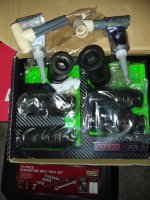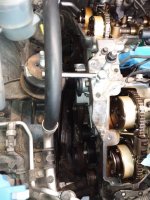Eventually I'll be changing the timing chain guide tensioner on the Kia 3.5 V6 in a Sedona, and was having trouble finding a good example of the timing cover process which lead me to look at other vehicles that have similarities. Fortunately I have some time and can add to the parts list as necessary, the plan is start disassembly after the garage is cleared but before the parts arrive, and if guessing eBay and Rock Auto, your right, I'm compelled to do everything on the frugal but blessed enough to be able to spend more on timing parts if necessary.
One tip was spray the dowel pins with penetrating oil as they may have corrosion and if the cover is not taken off evenly it may crack. At this point I went and looked but didn't see any I could readily access, so that may wait until disassembly reveals them. I got that from these guys, they have a couple of different video's, this one is a 4 cylinder, the introduction is usually about 2 minutes;
An example here at 33m the timing cover process starts;
The oil guy has a couple of references to use the Permatex Ultra Grey, and that's what I thinking as it worked well on the coolant valley plate Toyota 3.3. I'm thinking the aerosol can would be more convenient for dispensing but the tube works just as well as I'll roll it up with a long handle needle nose pliers if I don't have a tool or go the caulk tube method instead. Also the speed as which the work has to be done is has to be faster with the aerosol can, ad the job cost goes up at $20 - $25 - 9.5 ounce can, betting I go the least expensive route on this one.
Another thing is being steady putting it back in as I am not opting to remove the motor. Done this before on a 2003 Pontiac Vibe where I had to do it twice because it leaked the first time. The second time I put a extra bead of sealant on the lower 3 inches of the block half, and that time I used the Permatex Right Stuff aerosol can, I think $10 for the small can. This time I should look into a device I can slowly lower and control putting the cover into place.
It also looks like the valve covers should removed, first thought I could skip this but as long as time permits I want good access to as much as feasible. I may get the valve covers off yet today and the timing cover tomorrow, no hurry though as it will probably be an event that last over 2 weekends. I don't do this kind work everyday and appreciate any tips or guidance. At first it seemed like it was going to be an easy job, but I might overestimate my ability and underestimated the task. Now I better get to clearing and collecting some last minute supplies.
One tip was spray the dowel pins with penetrating oil as they may have corrosion and if the cover is not taken off evenly it may crack. At this point I went and looked but didn't see any I could readily access, so that may wait until disassembly reveals them. I got that from these guys, they have a couple of different video's, this one is a 4 cylinder, the introduction is usually about 2 minutes;
An example here at 33m the timing cover process starts;
The oil guy has a couple of references to use the Permatex Ultra Grey, and that's what I thinking as it worked well on the coolant valley plate Toyota 3.3. I'm thinking the aerosol can would be more convenient for dispensing but the tube works just as well as I'll roll it up with a long handle needle nose pliers if I don't have a tool or go the caulk tube method instead. Also the speed as which the work has to be done is has to be faster with the aerosol can, ad the job cost goes up at $20 - $25 - 9.5 ounce can, betting I go the least expensive route on this one.
Another thing is being steady putting it back in as I am not opting to remove the motor. Done this before on a 2003 Pontiac Vibe where I had to do it twice because it leaked the first time. The second time I put a extra bead of sealant on the lower 3 inches of the block half, and that time I used the Permatex Right Stuff aerosol can, I think $10 for the small can. This time I should look into a device I can slowly lower and control putting the cover into place.
It also looks like the valve covers should removed, first thought I could skip this but as long as time permits I want good access to as much as feasible. I may get the valve covers off yet today and the timing cover tomorrow, no hurry though as it will probably be an event that last over 2 weekends. I don't do this kind work everyday and appreciate any tips or guidance. At first it seemed like it was going to be an easy job, but I might overestimate my ability and underestimated the task. Now I better get to clearing and collecting some last minute supplies.


